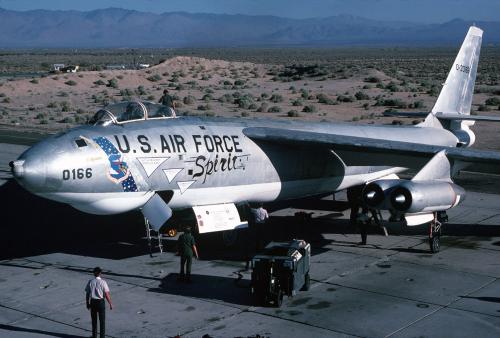
17 June 1986: After being returned to flyable condition, B-47E-25-DT Stratojet serial number 52-166, made the very last flight of a B-47 when it was flown by Major General John D. (“J.D.”) Moore and Lieutenant Colonel Dale E. Wolfe, U.S. Air Force, from the Naval Air Weapons Station China Lake in the high desert of Southern California, to Castle Air Force Base in California’s San Joaquin Valley, to be placed on static display.
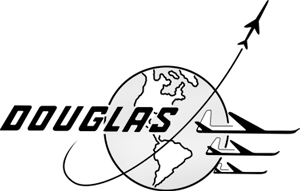
During the 43 minute trip, the aircraft had several systems fail, including airspeed sensors, intercom, and partial aileron control. On approach to Castle Air Force Base, a 16 foot (4.9 meters) approach parachute was deployed. This created enough aerodynamic drag to slow the airplane while the early turbojet engines were kept operating at high power settings. These engines took a long time to accelerate from idle, making a go-around a very tricky maneuver. Releasing the chute allowed the airplane to climb out as the engines were already operating at high r.p.m.
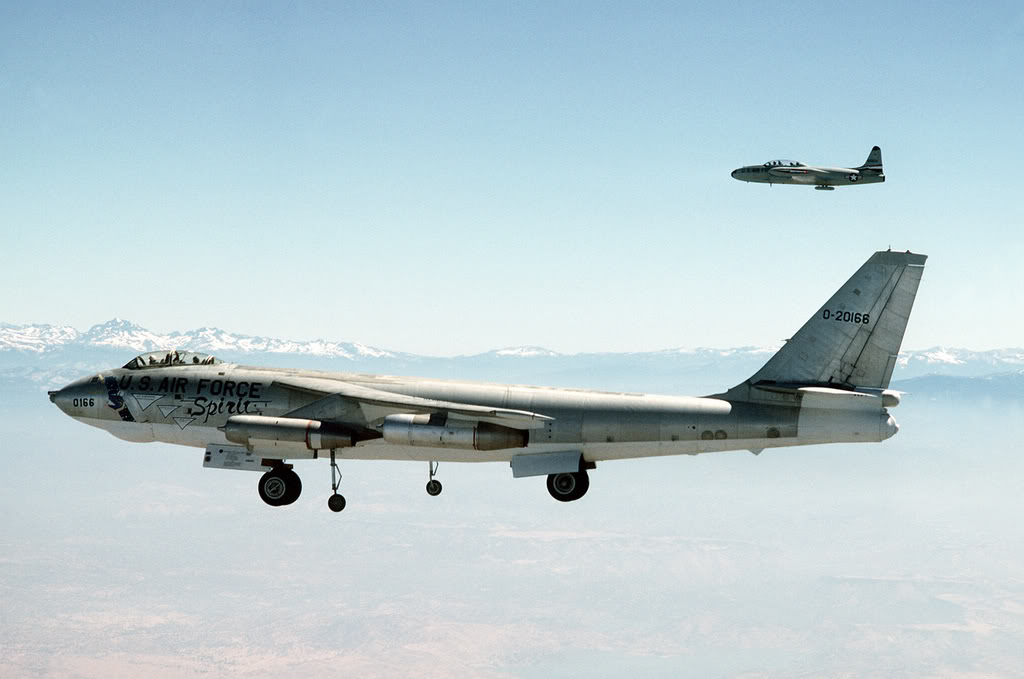

The B-47E Stratojet differed from the earlier B-47B primarily with upgraded engines and strengthened landing gear to handle an increase in maximum weight. The B-47E Stratojet is 107.1 feet (32.644 meters) long with a wingspan of 116.0 feet (35.357 meters), and an overall height of 28.0 feet (8.534 meters). The wings are shoulder-mounted and have a total area of 1,428 square feet (132.67 square meters). The wings’ leading edges are swept aft to 36° 37′. The angle of incidence is 2° 45′ and there is 0° dihedral (the wings were very flexible). The B-47E in standard configuration had an empty weight of 78,620 pounds (35,661 kilograms) and maximum takeoff weight of 200,000 pounds (90,718 kilograms).

The B-47E had a maximum speed of 497 knots (572 miles per hour/920 kilometers per hour) at 20,000 feet (6,096 meters), and 485 knots (558 miles per hour/898 kilometers per hour) at 38,600 feet (11,765 meters).
The service ceiling was 31,500 feet (9,601 meters) and combat ceiling 40,800 feet (12,436 meters).
The combat radius of the B-47E was 1,780 nautical miles 2,048 miles (3,297 kilometers with a 10,000 pound (4,536 kilograms) bomb load. Ferry range with 14,720 gallons (55,721 liters) of fuel was 4,095 nautical miles (4,712 miles/7,584 kilometers).
For defense the B-47E was armed with two M24A1 20 mm autocannons with 350 rounds of ammunition per gun. The remotely-operated tail turret was controlled by the co-pilot.
The maximum bomb load of the B-47E was 12,000 pounds (5,443 kilograms). The B-47 could carry up to six 2,000 pound (907 kilogram) bombs, or one 10,670 pound (4,840 kilograms) “Special Store”: a B-41 three-stage radiation-implosion thermonuclear bomb with a yield of 25 megatons).
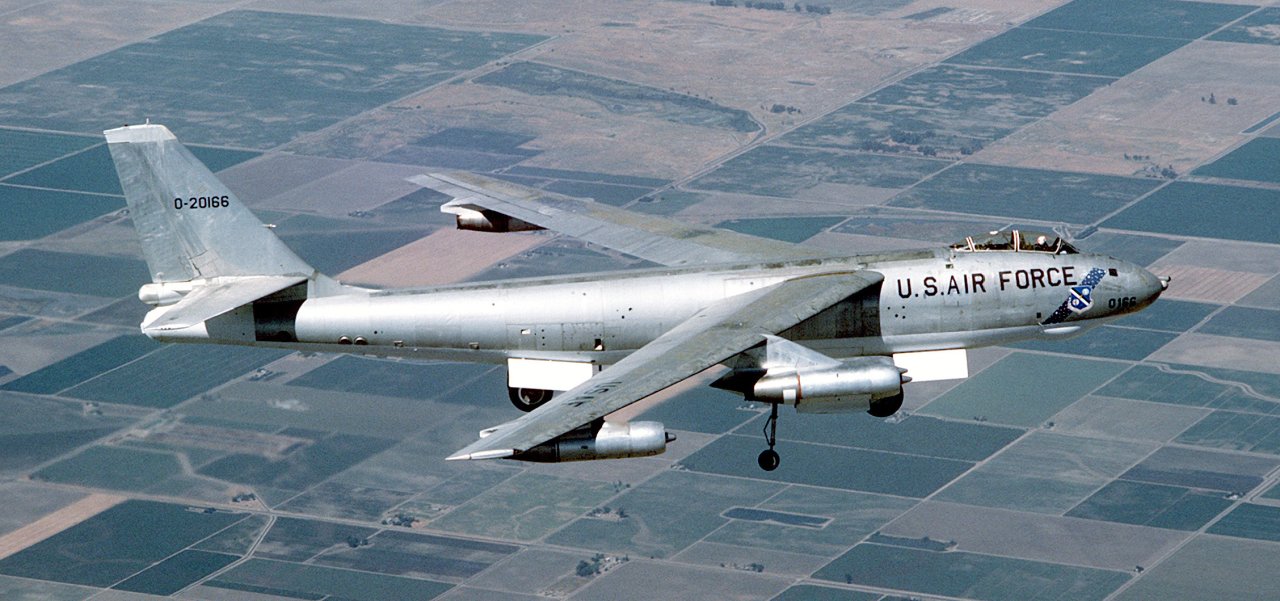
A total of 2,032 B-47s were built by a consortium of aircraft manufacturers: Boeing Airplane Company, Wichita, Kansas; Douglas Aircraft Company, Tulsa, Oklahoma; Lockheed Aircraft Company, Marietta, Georgia.
The Stratojet is one of the most influential aircraft designs of all time and its legacy can be seen in almost every jet airliner built since the 1950s: the swept wing with engines suspended below and ahead on pylons. The B-47 served the United States Air Force from 1951 to 1977. From the first flight of the Boeing XB-47 Stratojet prototype, 17 December 1947, to the final flight of B-47E 52-166, was 38 years, 6 months, 1 day.
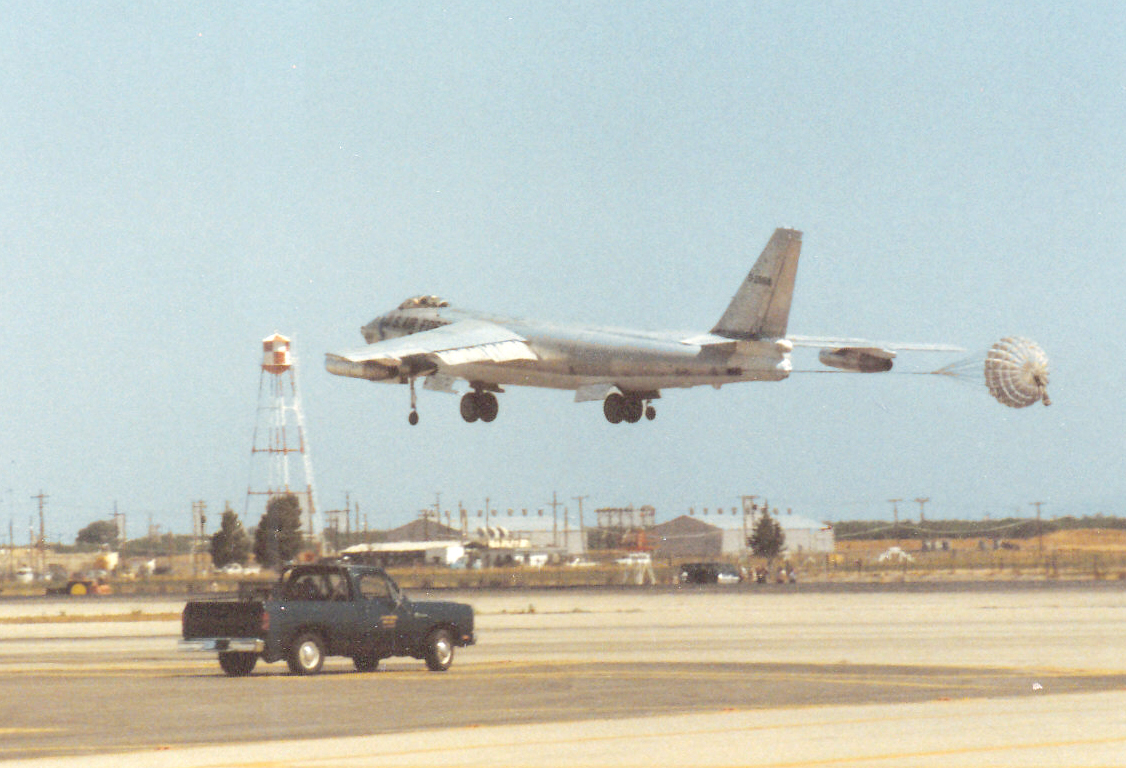
© 2018, Bryan R. Swopes
You corrected the engines on the B-47.
Thank you.
Thank YOU.
Our Dad, John Addington piloted B-47s out of Homestead AFB February 1959-February 1960, before attending B-52 pilot training at Castle. He then piloted 52s out of Loring July 1960-December 1964. Although he ended his AF career in a B-52, I think he always maintained a love affair with the beautiful 47!
I was at RAF Upper Heyford 1962 thru 1964.
i was an engine mechanicat d.m. in52 to55
I was at Whiteman AFB, Nebraska from 1956 to 1958. The Strategic aircraft at that time were the B-47 and the KC-97 refueler. I was transfered to RAF Station Fairford in 1958 and stayed there till rotating to SAC Headquarters at Offutt AFB, Nebraska. Both assignments were in the good company of the B-47; at Whiteman in the 340th Bomb Wing Medium, and at RAF Station supporting the reflexed B-47’s from 68th Bomb Wing.
When I was stationed at Oceana NAS in 1969-70 there was a B-47 on the flight line, I don’t know if it was being used by the Navy for weather research or had come in from the Air Force across the bay or what. That was about the coolest looking airplane I’ve ever seen. It looked like a giant fighter.
I know that two EB-47Es were assigned to NAS Point Mugu here in SoCal in the ’70s and were marked “U.S.NAVY”.
I was a navigator/bombardier stationed at Homestead AFB outside of Miami. My crew consisted of two great pilots, Bob Hamilton and Richard Wagner. I was there from 1959-1961. We would Reflex to Torrejon AFB, Spain. The B-47 was a wonderful aircraft and I enjoyed this article on its last flight.
Roger Shatanof
Coral Gables, Florida
I was stationed at Lincoln AFB, Nebraska from 12/63 until 6/66. I worked in base pay and was one of the last remaining airman before they locked up the base in June 1966. I always enjoyed watching B-47’s take off with JATO bottles…the last plane flew from Lincoln in December 1965 if my memory serves me correctly. We had two bomb wings..the 307th and the 98th. The air crews were always fun to work with at base finance…always gentlemen.
Was at Homestead AFB, Fla. from 58-62. Loved the B-47. Spent many hours with them. Glad they have some of them restored for everyone to enjoy.
I was a B-47 Crew Chief for six years at Smoky Hill/ Schilling AFB Salina Kansas from 1954 to 1960. Spent a lot of hours on the flight line working on these aircraft but was rewarded each time the gears hit the wheel well on takeoff. When that happen my thoughts were my job is done now it’s up to the flight crew to care for it.
My Son was at Castle going through B-52 Navigators training and watched Gen. Moore land this B-47.
Airborne it was the most beautiful aircraft around. It still is!
I agree with you, Pete. It was a beauty. 🙂
When I was a young Navigator-Bombardier on the FB-111, many of our crewmembers had started out on B-47s, been early cadre on the B-58 (THE coolest USAF acft ever! Got to see a 6-ship MITO (24 afterburners!) at Little Rock!), and then initial cadre on FB-111. They told tales of “Celestial Bomb Runs” in B-47 where the radar was not allowed to be tuned until 60 seconds computed from time to drop! And at NBT, the story was told of the B-47 over the North Pole when the emergency hatch over the Nav-Bomb blew out — taking all the charts with it in the explosive decompression. When the NB finally regained comms, the Pilot asked “What’s the heading?” The NB replied “South!”). They ended up landing on the East Coast instead of the West Coast!
That’s not a “breaking chute” as you call it but an “APPROACH CHUTE”. They allowed the pilots to keep a higher engine RPM on approach in case of a go-around. J47s were notoriously slow to spool up from low RPMs. Wish I could post a photo showing both chutes deployed during the landing roll.
John Stone, Whiteman AFB is in Missouri…current home of B-2 Spirits…
One of the first two Boeing XB-47s had been on display at the Chanute AFB Museum in Rantoul, Illinois. They were the very first examples of the type. After the museum closed it was disassembled and moved to Edwards AFB, CA where it is being restored for display. Like your article says, it is the Grandfather of ALL modern multi-engine jet aircraft featuring swept wings and engines mounted in pods on pylons.
Of the two that were built the single surviving XB-47 is 46-066.
46-065 was lost during testing.
I saw this aircraft land on this day, and have been back to the Castle Air Museum many times since to see her…
I wonder if that was the same General J. D. Moore that commanded Lowry AFB around that time. I prevented a looney tune former Lt. that he kicked out of the Air Force from gaining entry to the base to shoot him. Never got so much as a “thank you, Sergeant”.
Nope, just googled it. Wrong General Moore.
Thanks for the article Brad… Dale it has been my pleasure to have served with and known you as a friend, ski chalet mate and laugh partner at McConnell AFB Witicha, Mather AFB Sacramento, Carswell AFB FT Worth and Plattsburgh AFB. Thanks again for all those memories… Jack Devlin
I saw these beauties every day when I was stationed at Lockbourne AFB, Columbus Ohio (63-66). SAC left there sometime in 64, I believe and along with them the B-47s. Lockbourne became a TAC base at that time.
My Dad worked on the line in Tusa Ok and was sent to Germany to work on some nose problems they were having I don’t know much more I was just a kid but I saw one break up in the air over Tulsa when I was eating breakfast
Does anyone know how many B-47s are on display in various places around the country?
I know Plattsburgh has one.
Stationed at Clark AFB PI. 1967-69. The 47’s were parked right outside our shop. It seemed like everytime they returned from a “weather” mission. They came in on a emergency. Pretty plane
I was stationed at Morón AB January 1960 – Jan 1963 (15th MMS) and spent those years loading/un-loading thermonuclear weapons and 20mm armament on Reflex B-47’s. Base Commander (and my flight instructor) was Col Henry C. Godman, former personal pilot of Supreme Allied Commander during WW II, Gen Douglas MacArthur (6 degrees of separation).
This article brought a tear to my eye. Maj. George Byrum , navigator Capt. Bernie Stiles, and myself survived a crash of a damaged B-47 on approach to Plattsburgh AFB on Feb. 1964. Can’t say enough for the f ire dept. guys who probably saved our bacon. Lots of memories of reflexing to North Africa out of MacDill and to England out of Plattsburgh. Name Dale Wolfe sounds familiar.
Is that the drag chute or brake chute?
My Dad was a B-47 AC during Cuban Missile Crisis.
350th BS ” Red Falcons ” 100th BW Pease AFB
Portsmouth NH.
My 8th grade science teacher and friend Don Kinney was tbe navigator/ bombadier on one
…wish i knew more…woulda been with SAC around late 60s.
Great to read an article about the B-47! I was a Bomb-Nav Tech. Stationed with the 96th Bomb Wing, Dyess AFB, Abilene, Texas from 1959 to 1961. Not many people know what a B-47 is but it was a very beautiful aircraft in the SAC inventory.
Didn’t actually see the landing at Castle but watched tapes of it. It really was an “arrival” rather than a landing due to starting the flare too high. Touchdown was so hard one of the outboard engine pods actually hit the concrete! A note: The chute is the approach chute and it was deployed for approaches to keep the J-47s spooled up as has been noted but it usually was not jettisoned till after landing along with the brake chute used for the full stop.
Dale and I started aviation Cadets in class 59-F then I washed back to 59-G after a two week hospital stay with Pneumonia, but we went through B-47 academics at McConnell and flight training at Forbes. Went our separate ways in 47s and 52s then got together again in the cadre for the FB-111. Aside from being one of my early USAF friends he also happens to be my brother-in-law having married my sister who has unfortunately passed on.
Wayne Wachsmuth
I was there that day, with my dad…Before I retired I lived in Modesto, about 30 minutes north of Atwater (Castle Air Force Base). I have been to the Castle Air Museum many times since then. Great memories! Thanks!
Great article! Also enjoyed the comments. I’ll never look at a B-47 the same way again. Thank you!
You mistaking said the approach chute was released on a go around that is wrong , when practing goarounds the approach chute stayed attached to keep the J 47s at a higher RPM
My Dad worked on the B47 at Pease Air Force base in the early 60’s
I remember being at China Lake in 1984 while the plane was being prepared for the flight – so glad to hear what became of it!
My father was the NAV on the crew that went to Boeing to pick up the first B-47B. I have his 1000 Hour B-47 citation and lapel pin . His name was Edward A. Timmins. When he was grounded due to age, he was the oldest and longest flying SAC airman. He was on the only crew to receive two spot promotions or at least the first crew to get two.
I flew on the aircraft as crew chief at Lockbourne AFB, OH in the early 60s.
I was Bomb Nav tech on RB47e Forbes AFB Topeka KS 1954 to 1957
They flew the aircraft under the USAF Systems Command as no other command was willing to accept the risk of flying this aircraft.
I was a bomb/nav. tech on the B-47 in the 22nd Bomb Wing at March AFB from Feb. 1959 to May 1962. It wasn’t pretty on the ground but it sure was beautiful in the air.
I’m proud to have been in SAC. Peace was our profession!
Was at March AFB 1960 to 1963 & spent many hours flying as forth man on B 47 s
22 OMS
I was an Autopilot/Compass technician on the RB-47H stationed at Forbes AFB 1965-67. I have 3.75 flight hours in 53-4284 during a compass swing, required after changing the remote compass transmitter in the tail. I was TDY at Eielson AFB with snow on the compass rose, so we went flying.
There is one of the 32 RB-47Hs built on display at the National Museum of the Air Force near Dayton, Ohio. 53-4299.
I was at Mountain Home AFB 1962-65. If memory serves me correctly, that plane was
assigned there until they were phased out. If so, I worked on the radio system on that plane. Fine bird. Good times.
You can read more about the B-47 in my book, Jet Age Man: SAC B-47 and B-52 Operations in the Early Cold War. I loved flying the beautiful bird but was well aware of it’s limitations. From 1951 through 1965 251 B-47s were lost with 470 fatalities. Known details of each loss are listed in the Appendix.
I was at mtn 62 till 64 crewed with Sgt Davison 2 tours to guam.
The 53WRS was using WB47’s at Ramey AFB, Puerto Rico in 1979. They were then replaced with WC130’s.
There was a B47 Sitting (long since parked) at the air strip at Yuma proving grounds the summer of 1971. We (Army helicopter crew) got to climb in it at the time. I have heard it was later removed. Anybody know about this aircraft?
Engine mechanic on RB47’s from 1962 to 1966. Lot of engine runups done for that 4 years.
I was with the WB-47E at Hunter AFB, Savannah, Georgia. Then we went TDY to Clark AFB, Philippines for Operation Arclight. Then back to Hunter when most of the squadron was transferred to Ramey AFB, Aguadilla, PR . We were proud of our WB-47E because we flew them for every hurricane during that time. We are the 53rd Weather Reconnaissance Squadron, The Hurricane Hunters. The last of the active B-47s to be retired was 7066, and that took place in 1968. It was flown to the New England Air Museum.
I was stationed at Ramey AFB Puerto Rico from June 1970 to Sept 1971 with 53WRS which had just sent it last B-47 to the boneyard in may. It was reported that 3 emergency landing on 3 to 5 engines none on all engines. The last B-47 had tryed 4 times to get from PR to Florida before it made it
Thank you for this article was at Forbes 59-61 saw many B-47 most famous was little toy dog or (Snoopy) I saw the XB-47 at Rantoul just days before it closed said day in my mind always wondered what happed to it thank you
I was alternate Wing Weather Officer to the 97th Bomb Wing (B-47) Biggs AFB, El Paso from 1957-59, and Weather Officer at Upper Heyford (B-47 Reflex, 1960-63, and one summer there, the U-2).
Fond memories from a great article. I reflex out of Lincoln Nebraska to Maron Spain and RAF Upper Heyford England from 1959 to 1962. The B-47 had such a unique shape that “Ban The Bombers ” in England adopted the B-47 shape as a symbol for their protests. That shape ultimately was adopted worldwide as the Peace symbol.
In the early 1970’s I remember two B-47s parked on the transient pad at Minot AFB, ND. Amazingly, they belonged to the US Coast Guard!
Wayne Wachsmuth’s post about the landing at Castle is spot on. I was Flight Chief for the T-33 squadron stationed at Castle at the time, 84thFITS. Our birds flew chase with her from China Lake back to Castle. Never heard if it was a freak wind gust or the aforementioned aileron problem, but during landing rollout the left wing dipped and drug #1 engine HARD on the runway. There WAS an extended delay at the end of the runway….not too hard to guess what for. Just thankful some skills return exactly when needed and only injury was scratched sheetmetal.
My uncle, Leland Schmoker, was a B 47 pilot before moving over to the B 58. Said the B 47 was great training for the B 58.
I was more fascinated to see a T-33 being used as a chase plane in 1986. My father flew T-33’s Maxwell Air Force Base ftom 1955-1958 to maintain his flight hours while he was teaching at the War College. You think they might have used something a little more recent like a T-38. Then again the speed of a T-33 might have made it a better choice. Just hard to believe they were still flyingT-33’s in 1986.
Michael, I believe that the last Air National Guard T-33 was retired in 1987.